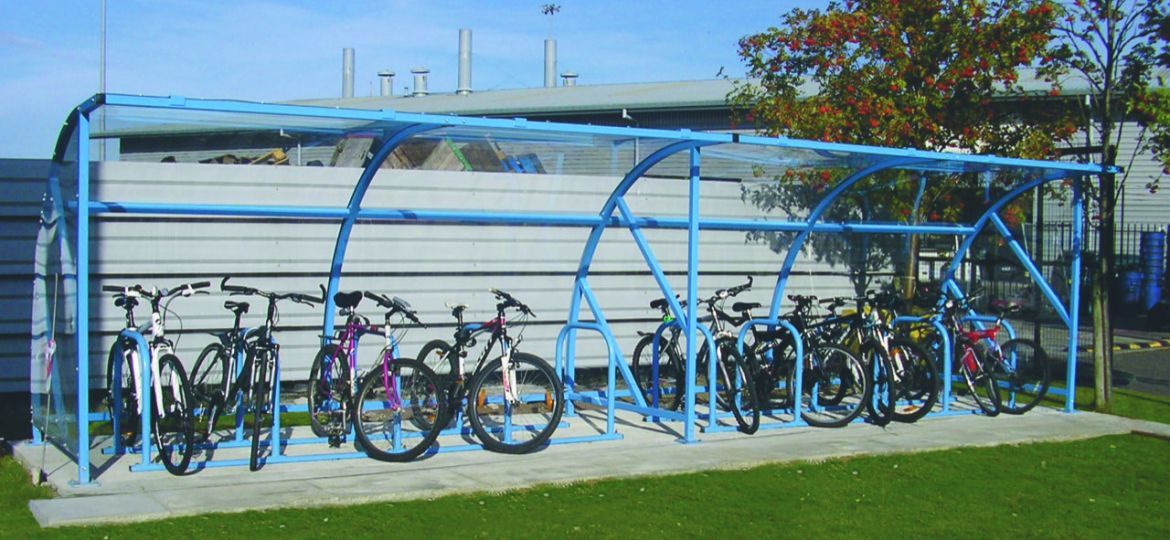
When the nights draw in and the weather turns, bikes are vulnerable to rust, dripping shelter panels, fogged glazing, and theft. Whether for schools, workplaces, residential developments or public buildings, a well-designed storage system ensures bikes stay dry, secure and ready for use through the colder months.
Why Autumn and Winter Storage Matters
In damp British conditions, moisture accelerates corrosion on chains, gear mechanisms and frames. A wet bike stored outdoors is much more likely to deteriorate rapidly. Shielded storage helps extend component life and keeps cyclists motivated during tougher weather.
Moreover, short daylight hours and bad weather increase the risk of theft or vandalism. Good design, visibility, and robust locking are critical to encourage consistent use.
From an organisational point of view, reliable cycle parking supports sustainability targets, reduces demand for car spaces, and encourages healthier commuting habits even in the colder months. Schools, councils and employers that maintain usable facilities throughout the year send a strong signal about long-term commitment to greener travel.
Hallmarks of Effective Winter Bike Storage
Cover & ventilation
A cycle shelter with a polycarbonate or Perspex glazed roof keeps rain off bicycles, while proper airflow reduces condensation. Wherever practical, a lockable bike compound offers additional protection without sacrificing visibility.
Security & sightlines
Locate bike parking where it remains in view of passers-by or building occupants. Well-lit surroundings and passive surveillance discourage criminal activity.
Tailored for short and long-stay users
- Short stay (visitors, customers): open shelters close to entrances with simple stands.
- Long stay (staff, residents): secure compounds or rooms with extra protection, possibly with densified rack systems like two-tier models, and lockers for accessories.
Durable construction
Steel frames with galvanised or powder-coated finishes withstand salt, grit and moisture. Roofs or panels should be replaceable and rugged to withstand winter weather forces.
Layout & Space Planning for Winter Conditions
When cyclists are laden with coats, bags or panniers, tight layouts become frustrating. Leave enough aisle width and rack spacing to allow manoeuvring even when dressed for the weather. Consider including some extra space or flexible zones for non-standard cycle types (cargo bikes, trikes) so these users aren’t excluded in winter.
Also design for future expansion: modular shelters or compounds that accept extra bays save hassle later.
An often-overlooked factor is surface treatment. Nonslip paving or resin-bonded surfacing under the shelter helps prevent accidents when shoes or tyres are wet. Good drainage should guide water away from stands rather than pooling beneath them.
Stands, Racks & Useability in Wet Conditions
Sheffield (staple) stands
Probably the most common and proven, dependable design supports both wheels and the frame, usable even with gloves and accessories in place.
Two-tier racks
Great when space is limited. Choose ones with assisted lift mechanisms and surface features to grip wet tyres. Well-engineered two-tier racks remain practical in all seasons if the mechanism is maintained.
Vertical wall rails or hooks
Useful where horizontal space is tight, just ensure clearance for handlebars, winter clothing bulk and easy access.
Including a mix of rack types ensures that all cyclists, regardless of bike type or physical strength, can confidently park.
Winter-Grade Security & Lighting
Dark, rainy evenings offer cover to opportunistic thieves. Encourage use of two strong locks per bike (for example, a D-lock plus chain) and include sturdy anchoring points in all stands and compounds.
Enhance security with good lighting, CCTV or camera coverage, and passive lines of sight. These features not only discourage theft but also boost confidence for users arriving or departing in low light.
Where power access allows, consider energy-efficient LED lighting with daylight sensors or timers, so illumination automatically adapts to early sunsets and darker mornings. A simple upgrade like this makes a noticeable difference to user safety and perception.
Seasonal Maintenance Checklist
Even a strong, well-built shelter needs care as winter takes hold:
- Clear gutters and drainage so water doesn’t drip or pool over bikes
- Inspect panels and glazing for damage or clouding, replacing defective components
- Check structural fixings and touch up any protective coatings
- De-ice or sweep access paths to keep foot traffic safe
- Service moving parts like gas springs or rollers on two-tier racks
- Communicate with users to dry and lube their bikes after wet rides
If you already have a sturdy shelter, refurbishment (panel replacement, repainting) is often faster and cheaper than full replacement, especially in the quieter autumn months.
Matching Storage Solutions to Your Site Type
Schools
Use visible, well-lit compounds or shelters near supervised areas. Install racks that are intuitive for students and consider scooter rack bays for primary age users.
Workplaces & campuses
Provide a mix of easy-access visitor parking and secure employee compounds. Two-tier racks help maximise capacity in constrained spaces.
Residential developments
Where indoor cycle rooms are not feasible, consider on-street lockable pods or multi-bike “hangars” to keep bikes dry and secure.
Public & healthcare buildings
Use wide aisles, non-slip surfacing, good lighting, and CCTV integration. Ensure ease of access for staff with varied shift times.
Designing for Sustainability
As more organisations focus on environmental impact, sustainable materials, and modular design have become key considerations. Recycled plastic benches or cladding panels, galvanised steel frames that can be recoated instead of replaced, and polycarbonate roofing that’s UV-stable and recyclable all contribute to a smaller carbon footprint.
Choosing British-manufactured shelters also reduces shipping emissions and supports local industry, an important factor for public sector tenders and corporate social responsibility commitments.
Many modern shelter ranges are modular, allowing panels, roofs and stands to be replaced independently. This extendable approach means less waste over time and easier refurbishment after years of use.
A Handy Specification Checklist for Tendering
- Combining option: Open shelters for general access + lockable compounds for long-term users
- Framework: Hot-dip galvanised steel, with optional powder coating
- Roof & cladding: Replaceable Perspex-glazed or polycarbonate panels, with gasketing or drip profiles
- Locking design: Racks that allow frame + wheel securing, solid anchoring
- User access: Adequate aisle widths, inclusive bays for wide/cargo bikes
- Lighting: Motion-activated LED lighting where power is available
- Maintenance-friendly: Replaceable parts, panel access, drainage pathways
- Sustainability: Recycled or locally manufactured components where possible
How Tamstar Supports You Through Winter
At Tamstar, we supply and install complete cycle shelters, lockable bike compounds, racks and stands, built to handle the harshest British weather. We also carry out refurbishment and glazing replacement on existing installations, regardless of manufacturer, ideal for improving facilities quickly before winter sets in.
Our experienced team, in most cases, carry out a site visit, assess space and user flow, and recommend the right combination of shelter type, layout and materials. Whether you need a compact unit for ten bicycles or a secure compound for hundreds, we’ll tailor the design to your needs, ensuring durability, security and ease of maintenance.
With autumn underway and colder months approaching, now is the best time to check your current storage. A few proactive upgrades can protect assets, encourage cycling, and present a professional, well-maintained environment for staff, pupils and visitors.
